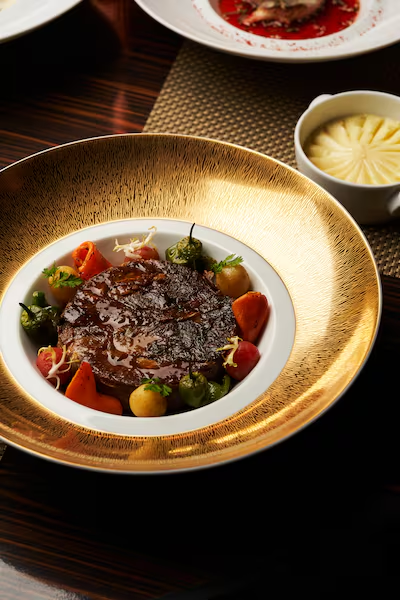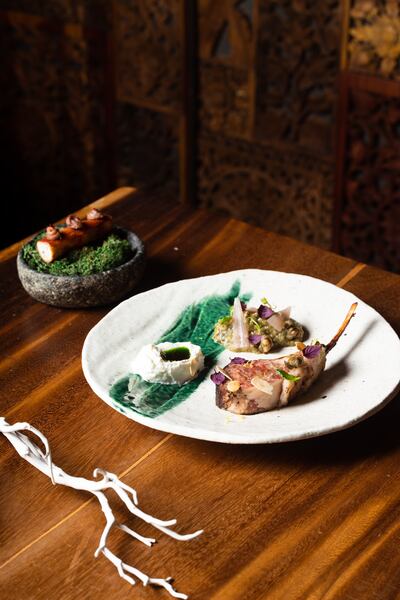Traditionally eaten at Easter, lamb is notoriously time-consuming to cook. It can also be paired with as many or as few ingredients as you’d like, and can be prepared between one and 24 hours in advance using both basic and state-of-the-art equipment.
Here, we present three chef-created recipes for all manner of home cooks.
For the time-poor: lamb ragout with tagliolini
Davide Galbiati, co-founder and executive chef at La Fabbrica Italiana, says: “This dish reminds me of the Easters I spent with family. My grandparents used to wake up very early to start cooking the feast, which was served banquet-style at noon. I can still remember all the different scents we used to smell when entering our building.
"Every year, my cousin and I used to play a game where we guessed which dish was being prepared in each home. Of course, our Nonna’s door was always the best-smelling one. I’m sure I could have made my way there blindfolded.”
Serves 2
Ingredients for the tagliolini and ragout
240g fresh tagliolini
100g butter
1 carrot, finely chopped
1 celery stalk, finely chopped
1 onion, finely chopped
300g lamb mince
1½ glass chicken stock
Ingredients for the Parmesan cream
100g cream
200g Parmesan, grated
Method for the tagliolini and ragout
Cook the tagliolini in salted water to your taste.
In a separate pan, roast the vegetables with butter on low heat until golden.
Add the lamb mince to the vegetables, and season with salt and pepper. Cook for about 35 minutes.
Add the chicken stock and cook until it reaches a creamy consistency.
Adjust with salt and pepper to taste.
Method for the Parmesan cream
Bring the cream to a boil, then turn off the heat.
Slowly stir in the Parmesan until you reach a thick creamy consistency.
Serving instructions
Combine the lamb ragout with the cooked tagliolini. Add dollops of Parmesan cream on top, then garnish with fresh parsley.
For the proficient: lamb shoulder ‘al Italian’

Roberto Torre, executive chef at L’atelier de Joel Robuchon, says: "Some of my earliest memories of cooking come from my grandmother and mother, in particular the 'Italian-style' lamb shoulder cooked for Easter.
"Here, I offer a revised version of an iconic dish. Something that’s more sophisticated, thanks to the slow-cooking, yet keeps the specific taste of my childhood and identity, and is an ode to my penchant to cook without artifices."
Serves 2-3
Ingredients
1.2kg lamb shoulder
Salt and Malabar black pepper, to taste
100ml olive oil
8g garlic
60g shallots (about 2 pieces)
10g thyme
10g rosemary
150ml chicken broth
200g potatoes
120g tri-coloured baby capsicums
140g cherry tomatoes
3g cornstarch
Preparation
Season the lamb shoulder with salt, pepper, olive oil, garlic, shallots, thyme and rosemary. Put the seasoned lamb in a vacuum-sealed bag and add the chicken broth. Seal the bag and place in a steam oven at 90ºC for 12 hours.
Method
Peel the potatoes and cut them into 1.5cm cubes. Cut the mini peppers and cherry tomatoes in half. Julienne the shallots.
In a non-stick pan, put the garlic and shallots with extra virgin olive oil. Add the potatoes and cook over medium heat for about 30 minutes.
In another non-stick pan, cook the mini peppers with olive oil for 20-25 minutes. Add the cooked potatoes preparation to the second pan. Then add the cherry tomatoes and thyme, mix gently to coat all the ingredients, add salt and pepper, and keep aside.
Once the lamb shoulder has cooked, let it rest for 30 minutes at room temperature but still within the vacuum bag. After 30 minutes, remove it from the bag, place on a plate and remove the bones carefully, while trying to keep the shape.
Recover the cooking juice from the bag, filter it, then reduce the juice over low heat in a saucepan until it forms a syrupy liquid. To obtain this, you can add a water-cornstarch mix to the juice, but be careful not to reduce too much as it could become too salty.
Add olive oil in a large and hot non-stick pan. Place the lamb shoulder and cook for about 10 minutes on each side to get a crispy skin.
Add the potatoes, baby capsicum and cherry tomatoes. Cook for 5 minutes to allow the flavours to blend. Serve piping hot with the cooking juice in a gravy boat.
For the professional: lamb chops with aubergine and anchovies

Mauro di Leo, head chef at Matagi, Raffles The Palm, says: “This dish is a twist on our Easter traditions in Italy. Growing up, we would share lamb with family and friends, and gather around the table to eat together. They are some of my favourite memories. But then I spent a lot of time working with the Japanese cuisine, and was enamoured by their respect for ingredients and their precise methods. With this dish, I wanted to enhance one my favourite flavours with some of the techniques I picked up during my time there, and blend my childhood memories with everything I learnt on my adventure.”
Serves 2
Ingredients
800ml rice vinegar
1L aka miso
1L shiro miso
2kg brown sugar
2 lamb chops
2 oranges
500g sour cream
2kg Sicilian datterino tomatoes
2 aubergines
2 lemons
2 bunches fresh mint
200g white sugar
2L water
2L apple cider vinegar
Black and pink peppercorns
2 star anise
2kg Tropea onion
2 Agria potatoes
500g goat’s cheese
200g Nocellara olives
6 Cantabrian anchovies fillets
Salt, pepper and extra-virgin olive oil, to taste
Preparation
First make the den miso by mixing the rice vinegar with the aka miso, shiro miso and brown sugar, and cooking for 20 minutes.
French the lamb rack, trimming the fat. Marinate with the cooled den miso and the zest of one orange. Vacuum-pack the lamb and let it marinate overnight.
Dry the sour cream by placing it in a cloth for at least five hours in the fridge.
Cut a small slit at the top of each tomato, then blanch them in boiling water for a minute. Peel and place the skins on a parchment-lined baking sheet and bake them at 90°C for three to four hours, turning the skins every hour. (A convection setting will cause the skins to dry faster, but check throughout the baking process to avoid burning.) After the skins have cooled, grind them in a grinder to form a fine powder.
Method
Score the aubergines with the skin on, then leave on an open fire (robata) for 30 minutes or until soft. Cut the aubergines in half, scoop the insides in a bowl, and season with salt, black pepper, lemon juice, chopped mint and olive oil.
Prepare the pickling liquid by mixing white sugar, water, apple cider vinegar, black peppercorn, pink peppercorn and star anise. Bring to a boil.
Clean and peel the onions, and cut them in small quarters. Pour the hot pickling liquid on top and let it cool.
Wash and peel the potatoes, and make two 5cm x 5cm sheet with a vegetable sheet cutter. Roll the sheets and make a cannelloni shape that’s 1cm in diameter, and season with salt. Steam at 100°C for 10 minutes, then dry and fry the sheets at 185°C until golden brown.
Wipe the goat’s cheese and add diced Nocellara olives, salt, the zest of one lemon and one orange. Put in a piping bag and set aside.
Heat some olive oil at 86°C, then add a bunch of chopped mint. Remove from the flame and blend with a Thermomix, making sure to be as quick as possible to retain the green colour.
Cook the marinated lamb sous vide at 55C for two hours. Once ready, open the bag and grill the lamb in the robata for a few minutes to give it a nice crust and smoky flavour.
Serving instructions
Make an oval-shaped quenelle scoop with the aubergine mix, then garnish with a mint leaf and the pickled onions.
Spoon the dried sour cream and fill the middle with the green mint oil.
Plate the lamb chops, season with salt and lemon zest.
Dust the potato cannelloni with the dry tomato and stuff the inside with the goat’s cheese mix. Garnish with three anchovies each, plus (optional) kiku flower and toasted Sicilian almonds.

